Marcel van Marrewijk's Blog, page 134
February 21, 2017
Productiever door Seats2meet
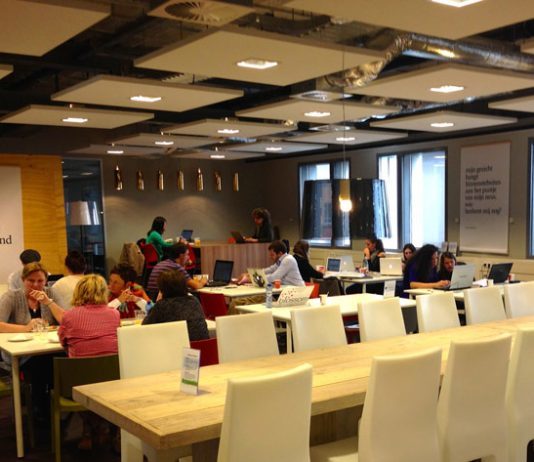
Naast mijn werk als freelance developer timmer ik de laatste drie jaar hard aan de weg voor een eigen online uren registratie tool met de naam Timi. Ik wil jullie in dit artikel vertellen hoe ik veel productiever ben geworden door een simpele aanpassing in mijn ritme.
Eind vorig jaar heb ik mijn werkleven behoorlijk omgegooid! Daarvoor werkte ik veel op locatie bij reclame bureaus maar met de geboorte van onze dochter besefte ik me dat ik meer thuis wilde zijn om Soof te zien opgroeien.
Daarom heb ik me voorgenomen om bij het aannemen van nieuwe projecten te vragen of ik gedeeltelijk remote mag werken. En wat voor mij een verrassing was, de meeste van mijn klanten blijken dat geen probleem te vinden!
Sinds ik meer thuis werk, besef ik hoeveel minder stress mij dit mij geeft. Thuis beschik je over je eigen omgeving, rust, je eigen computer en minstens zo belangrijk; je eigen koffie.
Ik moet echter toegeven dat ik me na een week thuiswerken soms ook wel een beetje eenzaam ga voelen, daarom ben ik een tijd terug begonnen met een klein experiment. Ik werk nu een aantal dagen in de week in de ochtend thuis; ‘s morgens is namelijk mijn meest productieve tijd. En na de lunch loop ik naar de stad om de rest van de middag bij een koffiebar of Seats2meet te werken. Het leuke is dat je al deze tijd mag gebruiken voor je urencriterium!
Ik doe dit nu ongeveer een of twee keer per week en merk dat deze wisseling van omgeving mijn focus op een positieve manier beïnvloed. Een groot gedeelte van onze uren registratie applicatie heb ik zo veel sneller kunnen ontwikkelen.
Ik vraag me af, zijn er meer mensen die een soortgelijke manier van werken toepassen en een soort digitale nomade zijn? En wat zijn jullie ervaringen?
—
Meer over Timi; onze uren registratie applicatie. Met Timi proberen we door onze simpele interface ondernemers te helpen 1225 uur te registeren zodat ze het urencriterium kunnen halen, en zo dus ondernemer kunnen blijven.
The post Productiever door Seats2meet appeared first on Seats2meet.
February 20, 2017
A ROADMAP TO SOCIETY 3.0: MASTER THE FUTURE OF ENTREPRENEURSHIP IN NL PROF. ERIK STAM
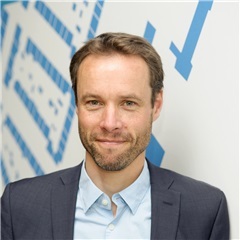
FEBRUARY 28, 2017 – 19:30 – 21:30
A Roadmap to Society 3.0: A gift for the residents of the city of Utrecht.
This spring opens SIFUtrecht in the former Staffhorst building its doors. As new residents of this place we like to give a gift to the people of Utrecht. We do this in the form of a series of six master classes by future experts.
6 master classes are given by:
February 14
Richard and Ellen Lamb – Trends 2017
February 28
Erik Stam – The Future of Entrepreneurship in NL
March 14
Herman Vissia – How the Internet predict the future
March 28
Lykle de Vries – Bitcoin / Block Chain
April 4
Fons Schoemakers – Collective Intelligence
April 11
Marije Lutgendorff – Crowdfunding
These master classes are free of charge!
The future of entrepreneurship in the Netherlands.
Erik strain is a professor at the Utrecht University School of Economics
Entrepreneurship – especially social entrepreneurship – is hot business. Tony’s Chocolonely to startups working with grandma’s from the neighborhood. For many Dutch it is a dream picture: his own boss while improving the world. How are things with entrepreneurship in the Netherlands? In this master class, come the facts and statements of entrepreneurship in the Netherlands on the agenda, and we go through four scenarios for the future of entrepreneurship in the Netherlands.
This first series of master classes compiled by Ronald van de Hoff, co-founder of Seats2Meet.com and author of Society 3.0.
With this series, it provides a complete roadmap for the future, and enough substance to talk with the experts and other audiences. Part of the master is that we are going the visitors ‘match’ on the basis of their knowledge so make use of artificial intelligence and the audience experience how we in SIFUtrecht ensure that the right people through our Serendipity Machine will meet there to cooperate and thus be able to make a contribution to society.
The post A ROADMAP TO SOCIETY 3.0: MASTER THE FUTURE OF ENTREPRENEURSHIP IN NL PROF. ERIK STAM appeared first on Seats2meet.
Productiviteitstips en inspiratie van co-working-helden
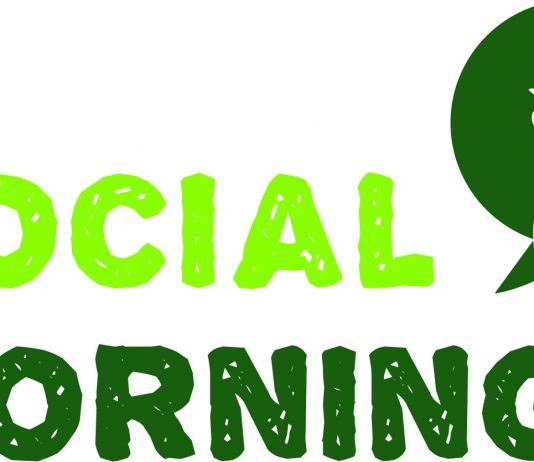
In Amersfoort zijn we een nieuw initiatief gestart: Social Mornings. In Social Mornings interviewen we lokale co-working helden over de “behind the scenes” van hun werkwijze en projecten. Productiviteitstips, favoriete boeken, ochtendrituelen alles wat mogelijk interessant voor jou kan zijn komt aanbod. 1 keer per maand live op locatie bij Seats2meet Amersfoort. Wil je inspiratie opdoen? Luister dan de podcast op www.socialmornings.nl.
In de verschillende interviews zijn we al diverse tips en trucks voor een productieve dag tegen gekomen. Waar kun je aan denken? Het lezen van boeken zoals The One Thing, War of Art of Getting Things Done. Het eten van vla of chocola en het drinken van Cola light. Maar ook goed nadenken over wat je wilt bereiken, tijdig rust te nemen en tijd met vrienden en familie te spenderen. Plekken waar wordt gewerkt? Dat is vaak een combinatie van thuis, bij seats2meet, bij de klant op kantoor, een eigen kantoor en heel soms in het bos.
Wil je zelf een keer aanwezig zijn? Je bent van harte welkom en hou onze Facebookpagina in de gaten. Op https://www.facebook.com/seats2meetstation033/ staan de komende events.
De volgende Social Mornings is op 3 maart met Audrey Zschüschen de altijd vrolijke vormgeefster van Studio Kiem. Wat kun je verwachten? Veel creativiteit, salsa, bordspellen, design, vechtsporten en wereldvrede. Zij heeft overigens ook het logo voor Social Mornings ontworpen.
The post Productiviteitstips en inspiratie van co-working-helden appeared first on Seats2meet.
February 17, 2017
16 FEB. THE 1ST SESSION OF “THE FIRST DIVE INTO THE MEANING OR SOCIAL IMPACT ‘WAS AN ADVENTURE
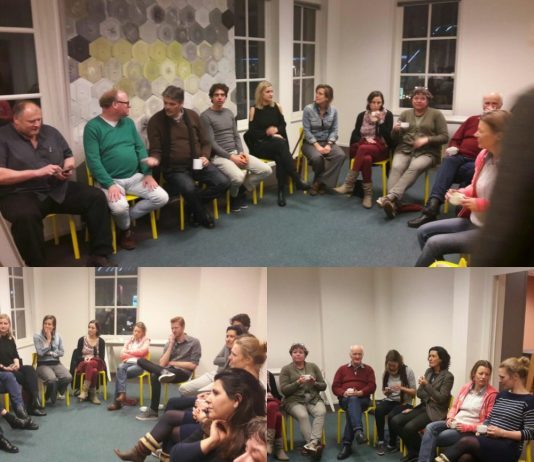 Tuesday Feb 7, the first session of the fourth round table conversations-no table headed by Cees Hoogendijk place. We asked Cees his view of this 1st session enter SIFUtrecht:
Tuesday Feb 7, the first session of the fourth round table conversations-no table headed by Cees Hoogendijk place. We asked Cees his view of this 1st session enter SIFUtrecht:Social Impact – how well are we doing and where we want more of?
Appreciating Research at the Social Impact Factory
Four round tables without tables and beautiful people
Step 1 of 4 – Social Impact at first but once discover
Cees Hoogendijk, imbued with humanization
Imagine going to do what she intends the Social Impact Factory in Utrecht contribute to greater social impact by social housing companies and encourage them to heroic feats. Imagine…
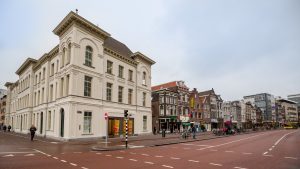
Photography: @michielton
What is that exactly, social impact? Something big? It’s very social issue? When I think of impact do I get the image of a bunch of fives. A big social bash? Is that what we seek? And get a lot of people not everyday a big social bash? What is actually NOT social impact?
Time to examine this. At least, that was Ronald van den Hoff, founder of Seats2meet , the patriarch of the book Society3.0 , meebouwer of the Social Impact Facory and a good friend of mine. He suggested four round tables and asked me to accompany “Of course Ronald, I’m always up for an act of asynchronous reciprocity. Humanization of Organization is my mission. All things considered, each neighborhood, city or society is also a kind of organization. 3.0 understood. ”
Four round tables; for me was immediately established that we were going to follow the four steps of the Appreciative Inquiry process. Also called true Office investigations. Using the widest possible diversity of participants we create the greatest possible sense of inclusion – everyone feels involved and co-eiegnaar. We consider a so-called Affirmative Topic – a guiding central question. And along the four D’s we effect change. Or maybe social impact. So by studying Social Impact we create social impact? Why not?
Our question: How do we make such a social impact that society will be a better place?
Tuesday, February 7 16 participants made it the first D. The The Discover. Discovering what we already know about social impact. Discovering what’s going well. Always go all things well. But then we must also questioning each other there. Appreciative Inquiry is not just a four-step process; it is also the art of asking questions generative; the art of the other out to endeavor to tell a powerful experience. In this case around social impact.
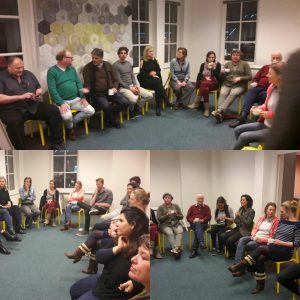
Sixteen people in eight interviewed a duo together. Not just because before you ask such a question, it is important to first meet each other as well. With a good meeting demand for example. Where are you from? What brings you here? What do you hope will happen tonight? What inspires you? What are you proud of? All wonderful encounter questions. And then: Tell about a situation where you were witness to social impact. How was that? What happened? Why was that experience so valuable that you want to repeat it now?
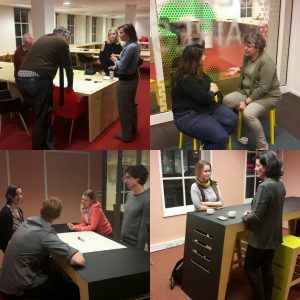
Can you imagine what happened in those eight pairs? Sixteen stories were hung in the air. Sixteen discoveries. In groups of four each told the others about the story he had heard or the other. And each group scored on a flip chart the red wires from the four stories. When we got back to our room all together, each group explained their flipchart. In one group had become clear that social impact need not always be great and compelling, but may consist of a single act of love for a fellow human being. (And if so, then millions of people billions moments of social impact along fortunate..) In another group emerged that – to be able to take care of your fellow man – especially should be good to yourself. It invited me to hear the beautiful song I love me Harrie Jekkers.
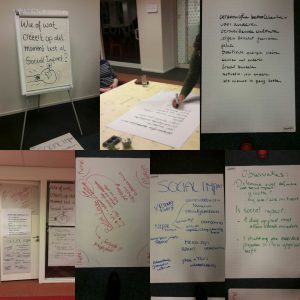
Discover so. Well, the four posters speak for themselves. What’s on it sometimes seems to be a description of what we wish, Amar is entirely based on true events. It is already there. How does that feel? That’s the power of Appreciative Inquiry. We are ready for the next step. The insight and confidence that give our discoveries, makes us ready for step 3 in our process – the second D Dream. Tuesday, February 21 we will go through that phase. (On March 7 we do design, and on March 21 Deliver …)
we see again our first sixteen participants? Have they all brought with a fellow human being? That would be a beautiful form of social impact. If we continue, we sit ip March 21, the fourth time in 128 people … Why not?
Increase social impact by examining the social impact to experience … you’ll also join on February 21? We’re going to meet again, so everyone will be made including to use Step 2 up. I think you already. Register via the link or go to the website of Social Impact Factory .
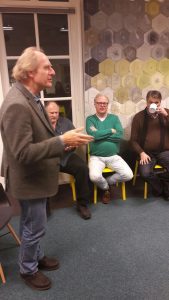
Curious about the art of Appreciative Inquiry? Then download my free book Inquiries Appreciative of the Child 3.0 – How to Meet, Share and CoCreate Tomorrows for Human Wholeness? www.appreciativeinquiries.eu . Sponsored by Society 3.0 Foundation.
The post 16 FEB. THE 1ST SESSION OF “THE FIRST DIVE INTO THE MEANING OR SOCIAL IMPACT ‘WAS AN ADVENTURE appeared first on Seats2meet.
February 16, 2017
Towards an Economy of Flow

A while ago I read an article in the Guardian which states that in order to combat climate change we don’t just need to switch to renewable energy, we need to create a new economic system. I have been doing some research of monetary systems and the economic eco systems they create for a while and after reading the article some extra pieces of the puzzle clicked into place.
Capitalism, an economy of acquisition
Our current capitalistic economic system is one of acquisition. Its goal is to acquire capital in its many forms. Real estate, factories, patents, web companies, … and ultimately the one to rule them all: money. And all these assets are perceived to be scarce. If I want something I can’t allow you to have it too because there is not enough for the both of us. This creates unhealthy competition and a world where the ‘get as much profit as possible’ business model is king. If you can’t turn it into a business model that creates profit you’ll have a hard time getting it funded. And it doesn’t end there. You need to make more profit every year because otherwise your business will be branded as a failure. Grow, grow, grow! is the mantra of the day.
This mentality is costing lives, literally! Real, life saving projects like the one that wants to create cheap, paper based blood test devices to be used in developing countries get left in the dust because they are not profitable enough.
In a world where perceived scarcity runs the show and it’s all about collecting as much as possible, greed is the only outcome. And we all know how that pans out. It’s a destructive force that eats away at our naturally helpful nature. It even has a measurable effect on 3 year olds.
But it doesn’t have to be this way. We created this economic system, which means we can also change it.
The components of an economic system
An economic system, at its core, consists of goods and services that are traded. A monetary system is usually used to facilitate that trade.
Now I’m sure economists will say I am oversimplifying things and I’m sure they’re right if we want to talk about the full complexity of economic systems. But take away goods and services and you won’t have much of an economy left. The complexities of the economic system arise from the wants and needs that are associated with these goods and services, and the design of the monetary system if one is used.
An economy runs in a society. You need people to have economic activity, even if those people use computers and robots to perform that activity for them (think smart trading algorithms on Wall Street). Since it ultimately comes down to running a well functioning society through economic and other activities, we can look at which economic activity we need in order to have this well functioning society. In other words, which goods and services need to be passed around (traded) in order to keep everyone happy?
The primary goods are clean water, food and shelter. Without the first 2 we’d just die, without shelter life can get very harsh, depending on where you live.
There is no real shortage of either of these resources, yet we see people starve from hunger, die from a lack of clean water and then I’m not even mentioning the countless homeless people who are sleeping on the streets all over the world. Why? The answer is simple. Because those people don’t have enough access to money. If they had, it would open the doors to clean water, nutritious food and decent shelter. Now neo liberalists will claim these people just don’t work hard enough and if they would they’d be lifted out of poverty in no time. Nick Hanauer states it differently in his TED talk: luck is a major factor in your success.
And the money? That’s just an agreement on what we use to represent real value.
The non-flow of our current system
The one big problem our capitalist system has is that it inherently creates a money flow from the poor to the rich. This shows in the figures. In 2010, 388 people owned as much money as the 3.4 billion poorest. In 2016 that number changed to 8 people holding the same amount of wealth as the 3.6 billion poorest. Money just has a strong tendency to flow to the financial world. Once it gets there it just runs around in circles, adding no real value to our society. But it does increase the wealth of the wealthy. The entire financial world is actually a huge pile of money just sitting there, doing nothing but shifting place from one pocket to the next. Sure, a little bit, according to some estimates around 15%, trickles down to the rest of us again. But obviously not as much as is being sucked into it. Otherwise it would be hard to explain the numbers from this chart that gives an overview of all available money that exists in the world. Here’s a small excerpt of those numbers:
$28.6 trillion: readily available money (coins, banknotes and money on accessible accounts)
$70 trillion: value of the stock market
$600 – $1200 trillion: value of the derivatives market
If trickle down economics would really be a boon for society then these numbers should be more in balance.
Why is this? The answer is fairly simple: hoarding money is rewarded with more money. Yes, this is a simplified statement but once you get your hands on your first couple of millions it becomes ever easier to increase that amount if you play the financial markets right. And when you have enough to spare you can spread your risks and make sure that there’s no real danger to losing it all.
But these people invest in business I hear you say. Yes, they do … if they can turn a profit from them. More often than not, a successful startup eventually turns into a money machine for just a few people. Take Uber for example. Who is getting rich you think? The drivers or the people at the top? Again, most of the money flows to … pools of money.
This is a mostly one directional flow, which is bad news if you’re on the wrong end of it. It looks like this:
Debtors and bank employees are also account holders but are displayed as separate entities to keep things clear.
The ‘real’ economy is the market of product and service providers which are not related to the financial market. Every member of this ‘real’ economy is also an account holder.
The money a debtor receives on her account is created by the bank, out of nothing. When the debt is payed back, this money is destroyed again together with the debt. The interest is profit for the bank. For a debtor, the income flow must be higher than the spending flow if she wants to be able to pay back the loan. That surplus on the income flow is at least partly used to pay for the interest on the loan and the bank costs. This process extracts money from the ‘real’ economy.
An account holder must make sure that the sum of his income, interest on his account and his profits and dividends are at least as high as his spending. Or become a debtor. If the income is high enough he can save some money for later. Once the sum that is saved reaches a certain volume the likelihood that it will be invested in the financial market rises due to the low to non existent interest that is gained on bank accounts these days. If interests were high, the money would just be kept in the bank, which also results of it ending up in the financial markets (see below). Once this happens most of the profits and dividends are probably reinvested in financial products, thereby keeping money in the financial markets. Also note that, if the income is largely received through the ‘real’ economy, part of that money now flows through to the financial markets.
Interests on loans, and profits and dividends from financial investments received by the bank which are not spent on wages and operating costs are also mainly reinvested in the financial markets. Banks also use a large part of your deposits for this purpose. This is possible because banks are not obligated to keep the total sum of all money on the accounts they manage available as reserve. This means that a lot of the money that people think is on their bank account is actually running around in the financial market.
As you can see, unless money is forced out of the financial markets, it has a strong tendency to flow towards Wall Street and consorts where most of it remains. This impoverishes the ‘real’ economy.
The model presented here is simplified but captures the core flows of our monetary system. It’s easy to see how the flows depicted by the orange arrows all contribute to helping money reach the financial markets. Once it reaches those, it tends to stay there. You could conclude that the financial markets are a dead end for monetary flows.
Creating real flow
Are there ways that would make sure money keeps flowing around in the ‘real’ economy and does not end up in an ever increasing stagnant pool which is just stirred around every now and then? For that we need to create the right incentives. As long as hoarding money pays off, hoarding will happen.
The town of Wörgl in Austria came up with a solution for this problem back in the 1930’s. It’s called a demurrage fee and it’s a tax on capital. It’s almost something like a negative interest. What it comes down to is this: if you want to hold onto your capital you’re gonna pay for it.
Now this may sound like strange idea, especially since we’ve been brought up with an interest bearing monetary system. But for Wörgl, it solved the economic crisis they were in. Since it discourages people to hold on to their money it automatically circulates. This vastly increases the chances that it comes back to you.
The creation of money needs to be changed too for this model to work of course. You can not create money from debt with an interest on it and then let it wither away through a demurrage fee. That would only make matters worse since interest would have to be paid from an ever shrinking pool of money. A demurrage fee would allow continuous creation of debtless money without creating out of control inflation though. Banks could be given an allowance for monthly monetary creation or it could be created for government spending on projects for the common interest or through a basic income. For this article it is assumed that it is created through a basic income because that adds some extra benefits to the economic eco system which will be explained below. How much that basic income should be is up for debate and outside the scope of this article. Let’s assume it gets created debt free and in large enough amounts to keep the economy going. What would be the impact of such a system?
The impact of real flow
Two things are bound to happen:
People will start feeling really uncomfortable because old models of capitalisation all of a sudden become moot. What good is it to have a large capital in the bank which just melts away through a demurrage fee?
The guaranteed basic income provides some security to counter that unease, at least for the average Joe.
Driving forces of a business
How can we deal with this change? What will business models look like?
Before digging into that question we need to look at what motivates people to set up a business in the first place. We can identify 2 non mutually exclusive driving forces: making money and following a passion. The first is simple and covers the range from making a decent living to wanting to become filthy rich. We could dive into the deeper psychological motifs that drive people to want to make lots of money but that’s beyond the scope of this article. The second driving force comes from within. It often clashes with the hard reality of our current system in which making money is an obligation for success. Unless you are rich already and have money to burn, which is usually not the case.
The new business game
If money is created through a basic income, setting up a business based on passion gets more leeway. People who want to work from this inner drive would then have more freedom to do so because they can tap into a guaranteed, never ending monetary stream which does not exist in our current system. Therefore businesses would not necessarily have to be profitable. They just need to be affordable for the people running them.
Those who want to make a profit will have to start playing a whole new game. Capital gain through profit is capped due to the demurrage fee, as the following simulation shows:
After a while the profit, calculated as revenue – expenses. balances out the demurrage fee paid on the reserve capital. This reserve capital fluctuates with the profit. If profit rises, so will reserve capital. If profit falls, so will reserve capital … even if the expenses remain the same.
Working with this kind of financial dynamic requires a whole new way of thinking about business models. Maybe some will claim it’s impossible to do business that way. Nothing is less true however. But people will behave differently when this model is released on them.
New possibilities
The first consequence of a demurrage fee is the fact that people will be more than happy to lend money interest free. Instead of losing money to a demurrage fee you can protect it from that fee by lending it out to someone else and create a new monthly income stream from it. Once people get used to working with monetary streams instead of capital even the habit of lending large sums might dissipate. That’s because passing around a large sum of money becomes comparable to passing around a hot potato. No one wants to hold on to it for long.
Now let’s look at possible changes in consumer habits and business models.
Saving for a rainy day
The amount of money we save for a rainy day changes in nature. Instead of a static pool which only changes when we either add extra money, earn some form of interest on it or retrieve money from when it’s needed, it now becomes a buffer which behaves like a dynamic equilibrium between our income and our expenses.
At first this might seem to be quite scary when we are stuck in the mindset of saving for when times get rough and our expenses supercede our income. We now create buffers for when we face big expenses or when our income drops from under our feet. But big expenses, which are the equivalent of big incomes for those on the receiving end are not really desirable for the ones receiving them unless they arrive at predictable intervals. Otherwise it is way more interesting to have the payment spread out over time in order to better manage monetary flows.
Also take into account that interest free loans have now become a possibility. Paying back these loans can always be backed by the guaranteed basic income, making access to new money easier. This basic income also functions as a replacement, at least at a psychological level, of our savings account. It would even provide more security than a savings account because a savings account can get depleted while a basic income just keeps coming.
There is a good chance that people will turn to physical assets as a way to ‘save’ for later. At least in the beginning. This has psychological reasons, namely that we are so used to needing some reserve that it could be hard to let go of that habit. This would increase the demand for these assets as an investment vehicle and could drive prices up. The downside of that would be that selling these assets would land the investor with a large sum of money which would have to be moved as fast as possible again. Where that would lead to exactly remains to be seen.
One thing is for sure though. As said before, since money keeps moving around the chances of it coming back to you are increased and those tough times might just be less tough to deal with.
It sure would take some getting used to but humanity excels at adapting to new situations and after a while people would probably wonder why it has ever been different.
Experiencing vs owning
Buying goods fits well with our current concept of capitalism. It’s an acquirement of something which is then held in possession. It’s static, just like the concept of capital. But as Thomas Rau points out in his presentation on the performance economy, we’re often not really interested in the product but in the services and experiences we get from it.
A car gives us a driving experience, a TV gives us a movie experience, a bed gives us a sleeping experience, … Right now we spend a large sum of money to then own something that gives us the experience we want. But in this new economy of flows, that one off large sum of money is not so desirable. Smaller sums of money that keep flowing into your business on a regular basis become way more interesting. We could all lease the experience we want without owning the product. As explained, this creates a business model that encourages producers to create long lasting, energy efficient products which are preferably repairable and recyclable. These producers in turn could pay for production experiences from their suppliers of tools and machinery. Thereby creating a sustainable production chain. In this model the products themselves remain in the possession of the manufacturers. Maintenance and operation costs in terms of energy and resource use also remain the responsibility of the manufacturer. The income streams are the monthly fees paid for the experience. The result of this is more predictability. Right now, when you market your product, your client has a one off transaction with your business when they buy it. You have no clue if or when they will do business with you again. They might keep the product for years if it lasts. Or they might buy a new one due to fashion changes or technological upgrades as soon as they come to market. RIght now a lot of business models run on planned obsolescence and then it’s hoping and praying that it works. A circular monetary system favors long term customer relationships which adds predictability to the financial situation of a company.
Consumers will manage their budget in a different way. Say I purchased a top notch movie watching experience costing me $150 a month. But then I change my lifestyle and become an active member of a sports club. I notice that I’m actually not using that movie watching experience that much anymore and I decide to downgrade it to a $25 experience for those occasions I still use it. Thereby freeing up some money for other experiences. The TV equipment is picked up by the provider of the service and replaced by something that matches my new fee. This set can now be installed somewhere else or recycled to be used in the production of a new generation of equipment. Reuse would get a huge boost and the cost in resources for the manufacturer would be minimal.
Another upside of these kinds of business models is that it might boost happiness of people. There is a possibility that consumers start thinking in terms of the experiences they want instead of stuff, which would alter their perception and shift their focus towards experiences. And research has shown that buying an experience makes people happier than buying stuff. That’s a win for both the business and the consumer.
A business model that runs on monetary streams and sells experiences would make planned obsolescence a thing of the past. Repairability, reuse, recyclability and upgradability would become the core values of a successful business. Imagine the impact this would have on our planet. That’s a triple win!
Down to the building blocks
Now take this line of thinking towards the manufacturers of raw resources: mines, farms, wood cutting companies, … The same kind of logic can not always be applied here. You can not remain the owner of a tomato you sold for example. Mining companies would probably have a hard time tracking their minerals and ores when they are handed off to manufacturers. What possibilities and challenges emerge for these type of businesses?
Food production
The upside of being a food producer is that people will always need food so they’ll probably have recurring clients and therefore fairly predictable income streams. Food is also an infinite renewable resource if the fields and waters which produce it are managed correctly. Their manufacturing equipment can be leased as a production experience, making the initial investment for a new company significantly smaller. They only need to pay for a production service that fits their scale. This kind of logic applies to every branch of production and gives small scale producers a better chance for survival. As said before, due to the basic income a startup doesn’t need to be profitable, only affordable.
The local, small scale initiatives we already see rising everywhere could get a huge boost from this too, thereby shortening the supply chain, decreasing pollution and making communities more self reliant.
Wood industry
Wood, just as food is an infinitely renewable resource if the forests are managed properly. It’s also a perishable resource, even though some wood types can last for years or even centuries. The more perishable wood types, which usually grow the fastest, would become the basis to build a recurrent client base with.
Clearcutting a forest for quick capital gain obviously wouldn’t be the smartest move when working within a flow economy. Sustainable stewardship of those forests on the other hand can create a regular income that is in sync with the growth rate of the trees.
Solely selling newly produced wood could become a hard thing to do when reuse, repair and recycling get a boost though. But as Gunter Pauli pointed out in his Blue Economy model, stepping away from the ‘one core business’ principle can easily bring in extra money here. Wood recycling can generate an extra income stream, as would tourist activities in those parts of the forest which are not actively being cut.
Mining and fossil fuels
Mining, the oil industry, the gas industry, … they are all inherently unsustainable businesses. It’s all about one time extraction resources and when the reserves are depleted that’s the end of the game. These companies would probably be facing tough times, especially when repairability, reuse and recycling become core values of a successful business model.
If they are future oriented they could get into a very profitable business however: recycling. It would be cost saving for manufacturers to be able to outsource their recycling to specialized sites. Mines, oil fields, gas fields, … these organisations have the space to build these facilities. They could also invest in buying up car graveyards for a boost in their output, thereby freeing up that space for something else. Maybe digging up waste might become one of the most profitable enterprises in an economy of flow.
Science and humanitarian projects, a matter of progress
Right now scientific research has a hard time finding funds unless the science can be turned into something profitable. Humanitarian projects have even a harder time finding funding because you just can’t turn something like eradicating poverty into a multi billion dollar business model. When money is leaking away through a demurrage fee however, people and organisations just might be incentivised to donate their extra money to these causes instead of just having it destroyed by the system. It would mean progress for all of us. Scientific research would flourish and humanitarian organisations would be able to access more and better resources and actually pay their volunteers, creating an extra incentive to work for them.
Lending capital?
In the introduction of new possibilities I talked about the possible abolishment of lending large sums of money. By now you probably see why receiving a couple of million in cash is not so desirable. So what happens when you want to buy a house or a piece of land or take over a business?
The one selling is probably not so interested in receiving the capital all at once unless she wants to buy something expensive with it right away. That’s not always the case though. When someone sells her business there’s a good chance she just wants to retire. Or when a couple sells their house they might want to downsize. In today’s economic system the extra cash would be set aside as a reserve. In an economy of flow that extra cash would just melt away. Not something you want.
Instead of the large sum, the seller is better of to negotiate a monetary flow, something that will keep coming on a, for example, monthly basis for a fixed period of time. Until the entire sum has been paid. Say I sell my 4 bedroom house because I want to go live in a 2 bedroom apartment in the city. Let the house be worth $400 000 and the apartment be worth $250 000 in today’s economy. I’d be way better of to negotiate a $2500 a month flow of money into my account for 160 months than scrambling to put those extra $150 000 somewhere. With the seller of the apartment I’d then negotiate $2000 a month payoff for 125 months, landing me with a surplus income of $500 a month for the first 125 months and a surplus of $2500 for the last 35 months. Not too bad I’d say.
The same could happen for buying businesses and other large investments.
Rich! How rich?
When you can’t get rich from hoarding capital, how do you get rich then? The answer is straightforward: you maximize your income stream. But here’s the catch: if you can’t spend it fast enough your wealth will cap and a lot of money is going to be wasted on demurrage.
This creates a completely different psychological situation from the one we have today. How much can you spend before spending becomes a job on top of the one which creates the income? How motivated are you going to be to get your hands on ever more income generating assets if in the end the income from your latest purchase is completely obliterated due to an ever increasing demurrage fee.
As long as we can get ever increasing returns from our endeavours we are motivated to continue. But with ever diminishing returns that motivation is very likely to drop. Thereby possibly creating a psychological upper bound to wealth hoarding.
Now I haven’t done research on this but if you look at game theory and research on human motivation and behaviour there’s a good chance there might be something here. Anyone up to do some research on it?
Conclusion
Since this kind of economic system hasn’t been implemented yet the conclusions drawn here can not be backed up with experimental data. Existing research on systems, motivation and incentives does provide some solid ground for these assumptions though. If they hold true, then we can create a sustainable, collaborative and caring society without needing a whole bunch of rules and regulations.
My question to you, the reader is the following: please challenge this work. Try to poke holes in it. Where do you see these assumptions challenged? Where do you see them standing strong and why?
This article is based on the monetary system described at Circular Money.
The post Towards an Economy of Flow appeared first on Seats2meet.
February 14, 2017
Je hoeft geen boer te zijn om buiten te werken
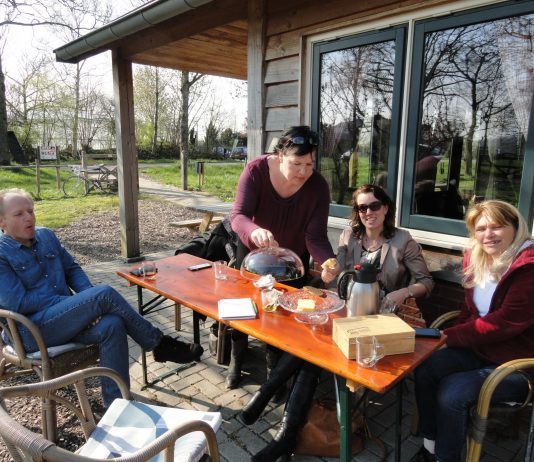
3 seizoenen draait de pilot al: “Seats4silence, werken en ont-moeten in de natuur”. Verschillende groepen en zelfstandig professionals hebben hun eerste sprong naar buiten gewaagd. Verschillende media schreven over ons. De visie spreekt aan. Nu naar nog meer gebruikers, zodat het duurzaam als platform kan gaan functioneren. Hoe we dat willen aanpakken bedenken we met elkaar. Bijvoorbeeld op maandag 20 februari as in de Monday Meetup.
Natuurlijk gebruiken we de opgedane ervaringen uit de pilot. Sybren Bouwsma heeft deze opgehaald met een behoefte onderzoek onder de deelnemende Seats4silence locaties.
samenvatting evaluatie
Betrokkenheid
Locaties zijn globaal in drie fasen betrokken geraakt bij Seats4silence: de pilot in de Kromme Rijstreek, de aangesloten locaties in Brabant, en tot slot aandacht in de media. Vooral vanuit de locaties die in de eerste twee fases zijn aangehaakt is er betrokkenheid bij Eline, maar er is relatief weinig betrokkenheid tussen de locaties. Wel is er een ondernemer die nu op de locatie van een andere Seats4silence locatie zijn workshops geeft.
Verwachtingen
Veel locaties zijn zonder veel verwachtingen aan Seats4silence begonnen, maar bij doorvragen komen drie verwachtingen als belangrijkste naar voren: het kunnen delen van de locatie, een betere profilering van de zaalhuur/accommodatie en het aantrekken van nieuwe of andere gasten. De precieze verwachting heeft ook te maken met de vraag of de verhuur van de locatie zelf een belangrijke bron van inkomsten is of niet.
De bezoekers die de weg naar de locatie weten te vinden zijn vaak verbaasd dat zo’n prachtige werkplek bestaat. Het delen van de mooie locatie is een verwachting die vaak is uitgekomen. Maar hoewel Seats4silence een ander, jonger en zakelijker publiek trekt, dat soms langer blijft, blijft de profilering van de zaalhuur/accommodatie en het aantrekken van meer gasten achter bij de verwachtingen.
Knelpunten
Een belangrijk knelpunt is het ontbreken van verbondenheid tussen de locaties: een gezamenlijk ‘Seats4silence’-gevoel. Ook is er veel onbegrip en onduidelijkheid wat sociaal kapitaal is, en hoe zij het als locatie in zouden kunnen zetten. Verder is de verbinding met Seats2meet.com een voordeel vanuit de netwerkgedachte, maar er zit een enorm verschil in karakter tussen de locaties van Seats2meet.com en van Seats4silence (en ook in de locaties onderling). Er is nu onvoldoende mogelijkheid om dat verschil goed te communiceren.
Een ander knelpunt is de digitale omgeving, vooral het boekingssysteem en de website. Verder vinden locaties het lastig om zichzelf goed onder de aandacht te brengen, vanwege de ligging van de locatie en vaak is men ook gebonden aan het seizoen. Ook is er onduidelijkheid over de afdrachten.
Wensen
De wensen en dromen van ondernemers lopen uiteen. Sommige locaties zijn meer gericht op de ‘nieuwe economie’, anderen staan er heel zakelijk in. En ook de locaties zelf en de omgeving waarin zij liggen geeft verschil in wensen. Maar uiteraard wil iedere locatie graag rendabel zijn/worden, en zoekt daarbij passende partners en klanten. Daarnaast dragen veel locaties de mens en natuurverbinding met passie uit.
Ondersteuningsbehoefte
De behoefte aan ondersteuning vanuit de locatiehouders ligt vooral op het gebied van PR en communicatie, zeker ook digitaal. Ook inzicht in de doelgroep, een goed prijsbeleid, en de inrichting van het terrein zijn onderwerpen waar locaties tips en ideeën vanuit het netwerk van Seats4silence bij zouden kunnen gebruiken.
Bijdrage aan Seats4silence
Veel ondernemers willen hun ruimte beschikbaar stellen voor bijeenkomsten, en ook graag hun kwaliteiten inzetten, bijvoorbeeld op het creatieve vlak of als ambassadeur om de voordelen van werken in het groen meer bekendheid te geven.
Toekomstwensen
Voor de toekomst is het formuleren van een gezamenlijke identiteit van belang, die best per locatie verder specifiek ingevuld kan worden. Vanuit die identiteit kan je een commitment met elkaar afspreken en werken aan meer verbinding, waardoor je ook meer van elkaars expertise gebruik kunt maken. Misschien dat de verbinding wel de vorm kan krijgen van een soort community, in een gesprek werd de vergelijking met couch surfing gemaakt. Vanuit een dergelijke verbinding zou de gebruiker of bezoeker van de locatie veel meer betrokken zijn, niet als toevallige passant, maar als iemand die zich echt verbonden voelt met een bepaalde locatie of het netwerk. Open dagen en gezamenlijke activiteiten kunnen helpen om elkaar locatie beter te leren kennen en je meer als eenheid naar buiten toe te profileren.
Lees hier het hele onderzoeksverslag
En je kan je hier opgeven voor de strategie sessie op maandag 20 februari 2017 Meeting Plaza Utrecht. Leuk als je mee wilt denken of je eigen buiten activiteiten wilt versterken met Seats4silence.
organisch ontwikkelen?
Hieronder kun je uitkomsten van vorige werksessies voor Seats4silence lezen.
Hoe kan ik effectief marktonderzoek doen? Lees meer>>
Uitkomsten Seats4silence Summit 1 juni 2016
Uitkomsten werksessie vraagkant voorjaar 2016
“Hoe kunnen we de kracht van het kleine behouden op de groene locaties van Seats4silence en tegelijkertijd opschalen?” Uitkomsten werksessie nov. 2015
The post Je hoeft geen boer te zijn om buiten te werken appeared first on Seats2meet.
Speaking on the biggest tech festival in the world Campus Party Brazil, a peak into a complete new culture of misfits and changemakers
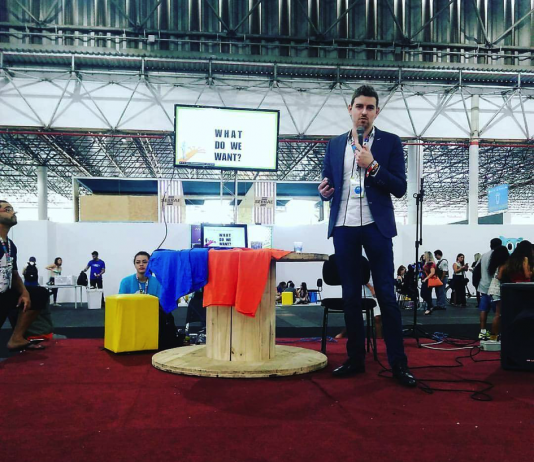
by
Last week I had the opportunity to fly to Brazil with social capital, I was invited as a speaker in November by members of communities, those who helped with promoting Campus party Europe last May I Co-organized.
Brazilians (over 150) that were expats in Europe that joined CPEU4 (Campus Party Europe #4) were from a community that call themselves Campus Party International Club, a Facebook group of 1500 members. They got a free tent at our event and they offered without me asking to come over to Brazil for the 10th edition there. I was not even seriously considering this was a real thing until they made an Campuse.ro event with my name on it as a speaker. Before I knew they had 34 people signed up for my talk and the organisation of Campus Party considered this as interesting enough to pay for my flight and really get a stage.
 Tents in Campus Party Netherlands
Tents in Campus Party Netherlands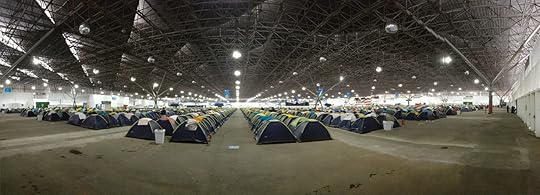 Tents in Campus Party Brasil 10
Tents in Campus Party Brasil 10I was extremely happy with such an opportunity, I never thought I would be ever speaking that far from home. 5500 miles away from the Netherlands in Sao Paulo. The community offered a place to sleep and I didn’t have to plan a thing… … Until 3 weeks before the event I received an email that my flight could no longer be payed for due a big sponsorship that dropped out.
I was devastated, had some weird nights of sleep and the community was sorry, they were not able to help me also on this flight but wanted to help with setting up a crowdfunding “Get Nick to CPBR10 for €10”. I shared this on my Facebook timeline and the first reply was: “where can I donate?” I was so emotional that a Facebook friend who I never met in person was so generous to donate that before I knew Society3.0 was sponsoring the complete flight. I couldn’t believe it and cried of joy. Before I knew it I was flying out from Amsterdam to Sao Paulo.
Community, community, community
Communities I was about to meet, 4 huge groups with 200+ members attending. They were all amazing. From lightsaber community, to Just Dance community, to International Campusero Club and Noibe, a young developers community. All were receiving me like they were my host for the whole event and that felt amazing.
Perks I didn’t expect
First they got me an apartment to sleep at, then they asked if I wanted to sleep in a tent as well and they arranged it! After a tour in the Arena I found my buddies from Campus Party Europe in NL who arranged me free food for the whole week, than I got Cabify (Taxi) discounts and at night they did everything to make me a decent caipirinha. I didn’t even mention the cheesebread I was getting on the airport when I was picked up by Rodrigo Almeida, the person that arrived first last year on our event.
The event
Days filled with 200 hours of presentations, workshops, tournaments & hackathons. I enjoyed amazing speakers, 7 different Hackathons, entertainment for day guests and activities ran by communities made that this week was going to be over soon. It was so great to see that even if you are Brazilian and never have to speak English at least everyone tried and were excusing all the time for their English even though I was really happy to be able to speak to so many, hundreds of Campuseros.
From world champions in Pepper robot dancing competition towards cheering for the lightsaber championship and laughing at hundreds of people dancing on ridiculous songs this was definitely an unconventional event that is powered by 10 years of outgoing nerds, gamers, makers and those who I can identify myself with when I turned into an entrepreneur after quitting gaming.

A wise lesson and practice
What I learned from them is: be accepting newcomers, whether it are refugees or just tourists like me you can learn a lot from them and they wish to learn from you. I was given so much that I want to do so much in return and that’s human, giving back and the trick is giving without asking something in return.
The amazing type of persons you meet there
Even though people there complained about so much corruption in their country and way too high taxes for entrepreneurs they were enjoying the moments in the Campus together. No one entered that Arena alone, no one left that party alone.
This reunited all those that live a digital life, many of them being lonely once back at home because they are misunderstood, they are the 1% misfits that can change society with their skills once they get a goal and mission in life. That was for me the biggest reason to be here: tell about my life as a gamer and how I changed it into becoming helpful for society what they could do as well.
Misfit represents for me someone that does not fit in the group or system. They have struggles finishing standard schooling, fitting in popular groups on school, sports, outside life.

Most of them miss social interactions during youth, most of them find these interaction in different worlds (f.e. Fiction/digital games). They don’t conform to fashion or looking good (for who?) they get their motivation through in game achievements, community achievements. Imagine 1% of society having interest in what you do, how hard is it to find friends nearby then?

I have had similar experiences, never stood out always the person caretaking of the community (in game). And on Saturday I had the opportunity to speak 45 minutes about it to around 40 Brazilian campuseros. My presentation was impactful I came to realize. I gave away two shirts from our CPEU and right after lots of young gamers, design thinkers for Ford, community leaders approached me and expressed similarities with my life and how this was an eye opener to them. They immediately wanted to change their life and around 5 high school students were promising me to start organising hackathons in their school. I completely lost my voice helping them one by one for several hours, some asking for advice for their brother who had zero interest in learning and was gaming 24/7. After this day I was accepting hundred Facebook friend requests from several communities over there. I introduced them to how to turn their society into our society and that it might be not so far away if they were able to look at abundance and start using it. Seats2meet they never heard of but in Sao Paulo we figured out over 20 hosts were there already, several post-normal organisations they had never heard of before that they would find amazing and made them believe they could change so much as an individual.
UN representatives, sponsors who believe in these misfits are in my eyes those who are helping so many hidden potential unlock in 1 week per year. Because if you train misfits in social and entrepreneurship skills and give them a stage they are the ones who can tackle any world problem and that’s why it bothers me that Campus Party Europe 5 won’t be this year in the Netherlands. Because short wins is not what you get here, its about enabling a community to put their hands on different challenges while having fun and meeting new like minded individuals. And pulling out sponsorships like what happened in the Netherlands is like saying they are not important enough. So I returned after this amazing week back in Holland and immediately joined the Campus Party Portugal organization to give people there the same stage I received to tell my story.
I hope to receive many Brazilian communities here (CPPT1 30-6 June/4-7 July Cascais, Portugal) to show how boring our individualistic and stressy Western life is compared to their collaboration culture. I vow for a mix of both best sides so we can solve global problems with global minds.
Thank you for your time to read this post. It was not possible without the last minute help of Society3.0, I want to especially thank Ronald van den Hoff for giving me the opportunity to be there.
Here you can find more photo’s of the week and the keynote that I gave
The post Speaking on the biggest tech festival in the world Campus Party Brazil, a peak into a complete new culture of misfits and changemakers appeared first on Seats2meet.
February 13, 2017
Locals welcome refugees
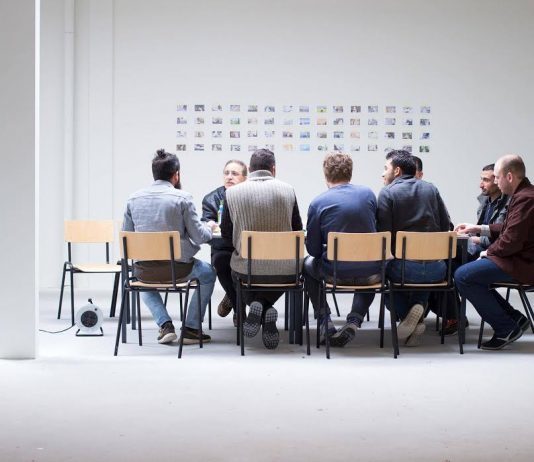
Around the world in your own backyard.
This sentence popped op in my mind some years ago. We have so many different cultures within our small flat country. So many possibilities to learn from each other. And to experience new country’s, languages and cultures (and just imagine all the great food!!!).
De Voorkamer is the newest S2M for Locals location and they are inspiring us!
De Voorkamer project is based on equality and individuality. It creates a framework for the participants to work on an assignment that fits them, that is meaningful to them and stimulates independence and personal integration.
They open their doors to newcomers and help neighbours get to know them, which helps a lot with the integration process. They organise together all kinds of events that are really worth visiting! Like boardgames every wednesday night, what about playing “sjoelen” or a fun game of Jenga? Want to know more about them? Watch this video.
Now they are also opening up their doors to invite you! You can book your seat right here.
We are in touch with more great initiatives like De Voorkamer. Plan Einstein in Overvecht is also a place to be for the neighbourhood and newcomers. Students, newcomers, entrepreneurs and neighbours everyone is welcome within Plan Einstein. Curious about their plans? Follow their activities here, or come in touch!
Also Taal Doet Meer helps to integrate refugees by helping with the language. They have all kinds of projects, like the language cafe, a walk through Utrecht where you are going in buddy’s to talk. Prepare yourself you will also dive in to different cultures, because Taal Doet Meer believes that everyone should understand how it feels to learn a new language. So if you join with one of their activities you will experience how it feels like to learn a new language.
If you would like to promote those connections and initiatives you can e-mail Nynke! To know everything about it, like the S2M 4 locals facebook page and keep up to date!
After all, what a better way of connecting to someone than to sharing your living room, kitchen table or work office? We hope that you will work and meet soon at one of these locations. You can already book your place at De Voorkamer. Book here and meet different cultures, disciplines and talents just around the corner.
More information about S2M for locals?
The post Locals welcome refugees appeared first on Seats2meet.
Voordat je gaat stemmen…
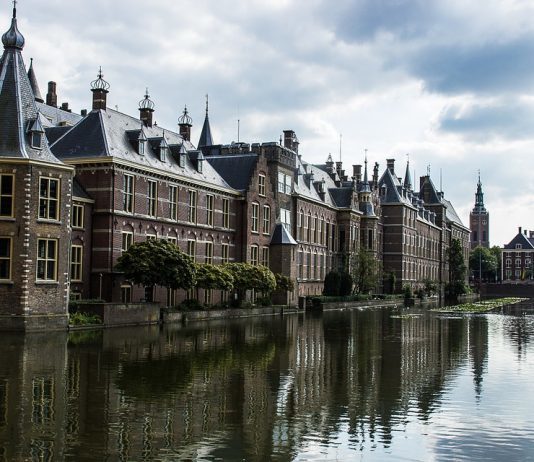
MEER BANEN. LAGERE LASTEN. MEER GELD NAAR DE ZORG. GRENZEN DICHT….ik zou zeggen, trap er niet in.
Het is een veel gehoord verhaal. Verkiezingen zijn in aantocht. In veel verkiezingen verhalen is de flexwerker ergens uiteindelijk de gebeten hond, of de hond die bijt. Ik weet ‘t niet. Wat ik wel weet is dat mensen komen en gaan in de flex-wereld. Dat zou slecht zijn voor hunzelf en voor de lerende cultuur van organisaties, omdat de tacit knowledge, de ervaringskennis, gaat ontbreken. Aan de andere kant zien we bedrijven experimenteren met de ‘agile methodiek’ voor organisaties, dus het wendbare vermogen van een onderneming gebruiken. Dat komt de innovatie- en productie kracht ten goede. ‘Wendbaar’ zijn met vaste werknemers is inmiddels wel een soort ‘contradictio in terminis’ gebleken.
Asscher en Wiebes met hun Wet DBA sloegen daarom ook flink de plank mis. Zij projecteren hun gedachten op oude aannames en oude structuren en gaan eraan voorbij dat sociaal economische waarde creatie binnen de verouderde lineaire waardeketen van organisaties aan het veranderen is in een systeem van waardenetwerken. Hierdoor nemen die traditionele organisaties massaal afscheid van de vaste werknemer en organisaties, die dat niet doen, bestaan over 5 tot 10 jaar gewoon niet meer.
Dit is pas het begin: de robotisering, algoritmes en de kunstmatige intelligentie zorgen er ook voor dat het begrip ‘werknemer’ feitelijk gedateerd is. Daarboven op zijn er dan nog de nieuwe Nederlanders, die ook willen werken. Mensen bij wie de woonomgeving zo vakkundig verwoest zijn dat ze in het ‘thuisland’ gewoonweg nooit meer een huis zullen hebben om naar terug te gaan. Of we onze grenzen nu sluiten of niet, dat worden er gewoon nog meer.
Natuurlijk is het een uitdaging om het goede van de oude samenleving en haar organisaties (zoals de cultuur, het ‘ergens bijhoren’ en die tacit-knowledge) te borgen in de nieuwe economische samenwerking verbanden (de co-working trend laat overigens zien dat zoiets prima kan). Ook dienen we ervoor te zorgen dat mensen een (basis)inkomen kunnen verwerven. Dat lijkt me een betere oplossing dan het visieloos proberen de vernieuwing terug te proppen in de traditionele vakjes op het speelveld van de vorige eeuw, wat onze bestuurlijke, wetenschappelijke en politieke elite maar al te graag wil. Dat staat de werkelijke en broodnodige vernieuwing van de samenleving van onderaf in de weg. Alle politici met de bekende verkiezing-retoriek ten spijt. Het resultaat van dit regenteske en elitaire gedrag hebben we in de VS kunnen zien. Laat dat toch niet onze weg zijn!
The post Voordat je gaat stemmen… appeared first on Seats2meet.
Check: This is how the expectations about the sharing economy in 2016 turned out
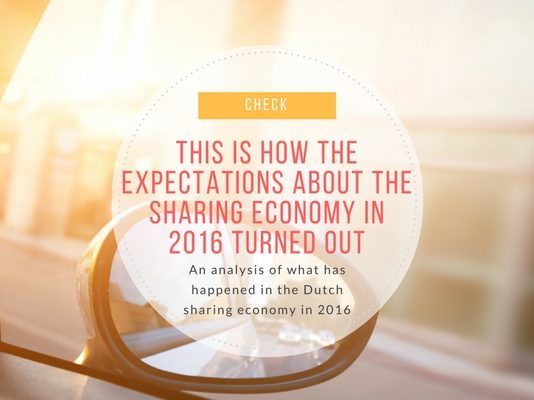
As an entrepreneur you’re looking ahead, yet you also reflect on past events to learn to analyse what has happened, and to adapt your strategy accordingly. When entrepreneurs reflect, why do experts hardly ever follow their example? I’m taking the challenge by reviewing my ‘5 predictions about the Dutch sharing economy in 2016’ .
1. ‘Traditional’ companies take the step into the sharing economy
The prediction:
“Traditional (corporate) companies will join in the sharing economy themselves. The automotive industry will be taking the lead. Also corporates like Facebook and Google will join the sharing economy.”
The reality:
The first steps into the sharing economy by corporates where as expected mainly investment and acquisition based. AccorHotels acquired the high-end Airbnb variant onefinestay.com for about 170 million and directly promised to stimulate the development of the platform with another 70 million.
In the land of mobility, corporates knew to find the start-ups as well. A great way stay current with the newest developments. General Motors, for example, invested 500 million Dollar in Uber rival Lyft. In time, the company wants to use Lyft as a platform for its upcoming self-driving car’s.
Own initiatives were deployed by BMW, among others. The company announced a pilot with 40 self-driving taxis in Munich just before year’s end.
Especially insurers have been exploring their future during this year. A Dutch insurance company, Centraal Beheer, started a pilot by offering insurances for shared cars in late December and OHRA experiments with Clixx: an insurance that allows you to insure your car for a single day for sharing purposes.
The prediction that sharing activities would be started by Facebook and Google has turned out to be mistaken. Only Facebook launched Marketplace this year and Google experimented in ‘ride sharing’ with Waze. Both (still) with minimal impact. And that’s about to stay that way for a while, I expect.
In many segments corporates are clearly not taking the lead, but like BMW’s vice president Klaus Buettner said, “Someone else spent the money to educate the market and then we came in with a cool product. We will not be the largest, but we can be the coolest.”
Question of definition:
However the sharing economy is the most frequently used name for this development, I also see a rise in the the terms ‘collaborative economy’ and ‘(peer2peer) platform economy’. The core of these developments is that individuals find each other through platforms in order to make transactions. In this article I’ll be using both sharing economy (things) and ‘gig economy’ (labour/tasks). To keep this story accessible for the reader, I decided to use sharing economy as an all encompassing term, knowing it might not be the ideal terminology, although it’s most recognizable.
2. Greater supply of sharing platforms
The prediction:
“A huge growth in the number of sharing platforms.”
The reality:
However the supply in absolute numbers has grown, the growth in number of platforms is disappointing. Especially in segments that are already well represented (accommodation and mobility) fewer companies started. All in all, it seems that the sharing economy market for platforms with serious growth ambitions has been satisfied.
In case new sectors are added, more entrepreneurs are starting at the same time. This year sharing platforms offering storage space launched. In the Netherlands, both Djeepo and Storage Share started at almost the same moment. It was the very same story with Dutch based campervan sharing platforms Camptoo and GoBoony in 2015. See here the complete overview of sharing platforms.
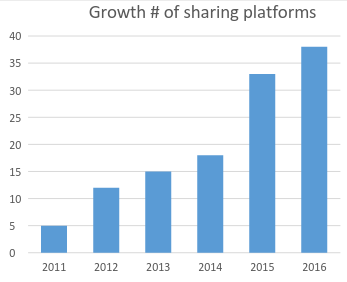
3. Growth through partners and APIs
The prediction:
“Platforms will open their APIs for others, so they may grow faster.”
The reality:
This prediction can clearly been filed in the category ‘the wish is the father of the thought’. To me, growth through APIs and opening up to others is a reasonable step within the sharing economy. Entrepreneurs still don’t seem to have their business organized well enough to take this step. Many platforms enforce their own market position first, and are only then looking beyond their own abilities. Sharing within the sharing economy is still hard.
4. More on-demand working platforms
The prediction:
“A growth in platforms facilitating (lower educated) labour. Rising discussion about the durability of these kind of platforms.”
The reality:
However Uber, Helpling and Werkspot made again good progress in 2016, the growth in number of platforms for temporary work in the Netherlands stalled. The growth occurred mainly in the ‘on demand’ delivery of fresh food, where UberEATS, Foodora and Deliveroo launched in a number of larger cities. The battle in the delivery market is turning towards the question, who is not only going to have the digital, but also the physical contact with the customer. This, again, can be seen in the acquisition of the German Resto-in by Takeaway.com just after the change of the year. In the United States, many more similar platforms are active and I noticed a strong growth over the last year. Additionally, the discussion about the inequality of these platforms was stirred.
Laborers are earning less and less in the USA, though platforms offer employees the opportunity to change their fate. 2016 has been the year of ‘platform coops’, i.e. platforms being owned by the people on the job. In Denver, a taxi platform cooperation of about 600 drivers had put together 2.000 USD each to build their own taxi-app. In the meantime the have grown an impressive market share of 34 percent in the region where the cooperation operates.
5. The market will mature
The prediction:
“Platforms can’t hide behind their ‘disruptive’ character any more, and will take their responsibility.”
The reality:
This prediction has absolutely been fulfilled. Although platforms grew exponentially in their first phase, I noticed a few platforms making choices that impact their short term growth negatively in 2016, this to strengthen their raison d’être on the long run.
For example, Airbnb made agreements with the governments of Amsterdam and London, amongst others. The company programmed local legislation into the platform. According to Financial Times the company hence forfeits a yearly income of about 382 million euro in London only. Calculating these short term losses is a characteristic of thinking short term. In case Airbnb wouldn’t have done so, other measures and legislations would have affected the business anyway. Now they’re working on a solution together, i.e. this step has been essential to the company’s long term raison d’être.
Every well-thinking entrepreneur could have anticipated this move of Airbnb. Under the cover of disruption and innovation, platforms like Airbnb were able to grow rapidly in a very short time, also due to the confusion about legislations, though they knew that the time would come they had to conform to existing rules.
You may also recognize smaller platforms that use the hard lessons large pioneers like Airbnb have learned. AirdDnd, a platform for home restaurants, proactively offered a legislative proposal in order to direct the discussion with the status quo into a manageable environment from the very beginning.
Additionally, public authorities are taking the sharing economy more and more serious. Last year I’ve been speaking with Dutch institutions like the The Social and Economic Council of the Netherlands (SER), Netherlands Bureau for Economic Policy Analysis (CPB) and the Dutch Ministry of Finance about the impact of this development. It truly seems that the sharing economy is maturing and that offers a more durable perspective for the future.
The post Check: This is how the expectations about the sharing economy in 2016 turned out appeared first on Seats2meet.




